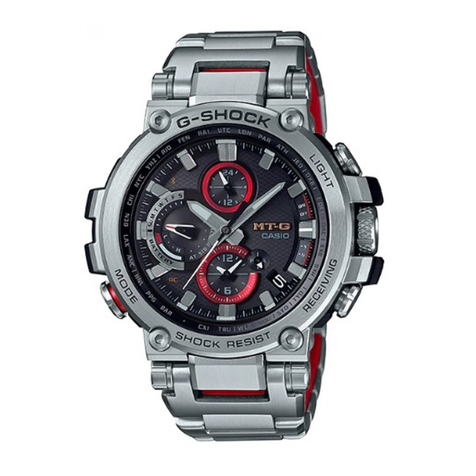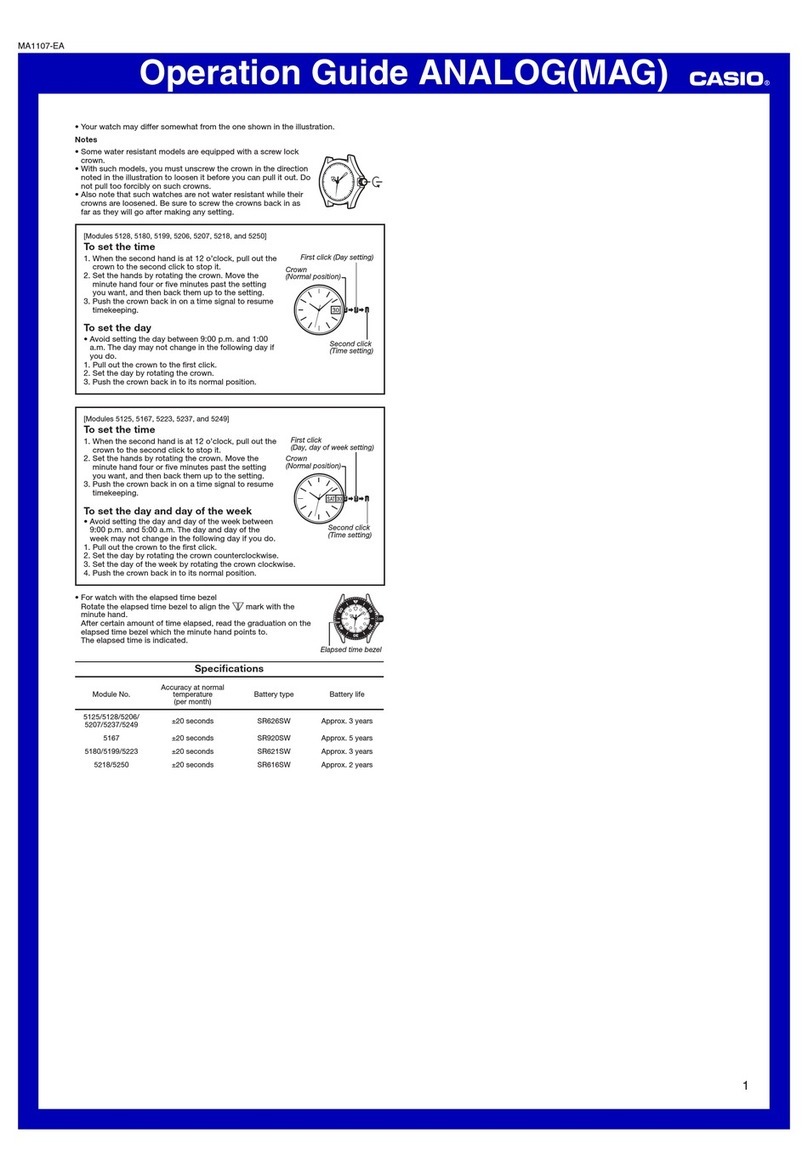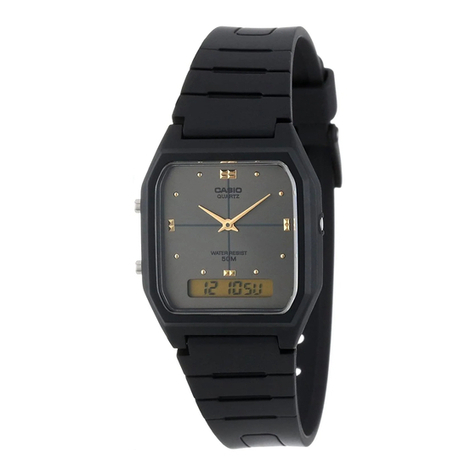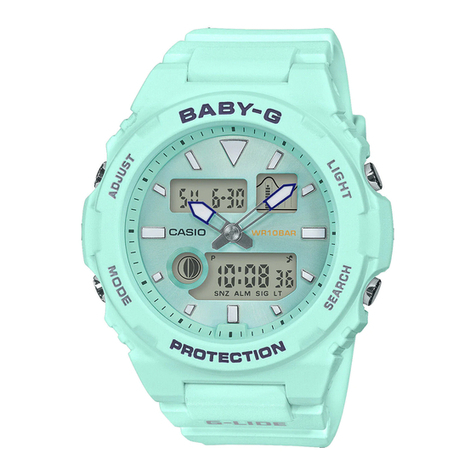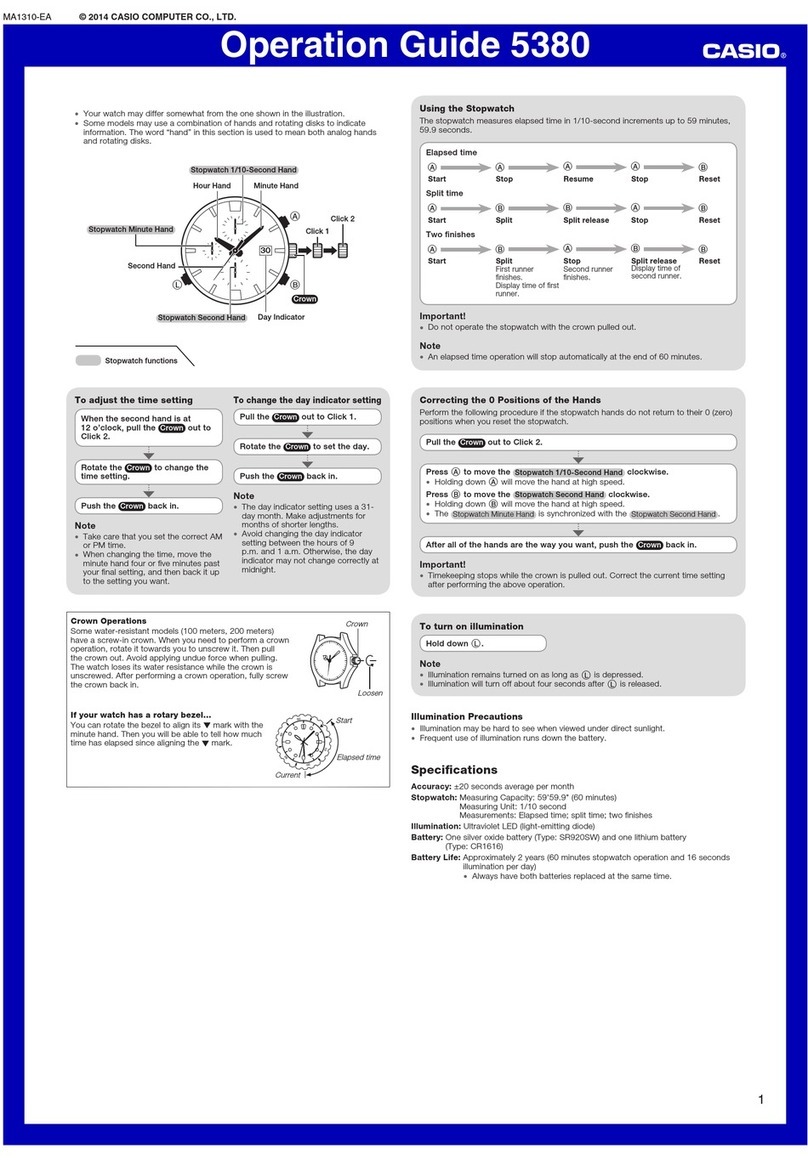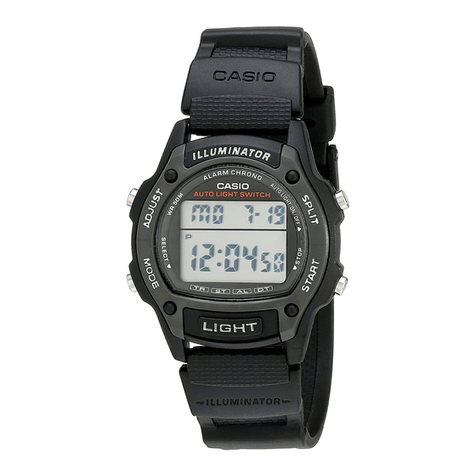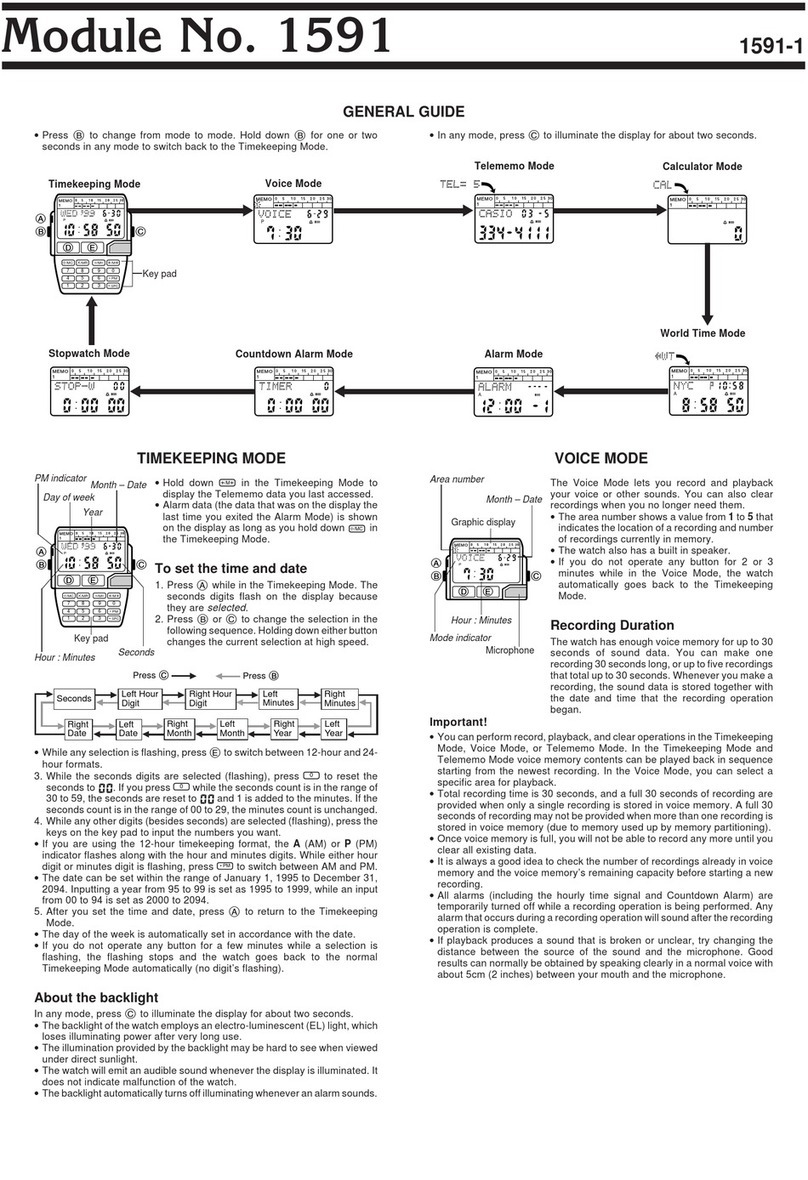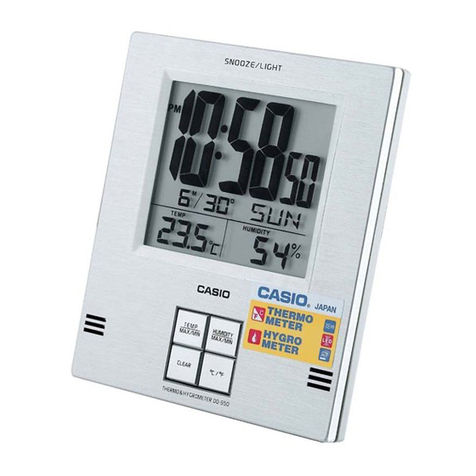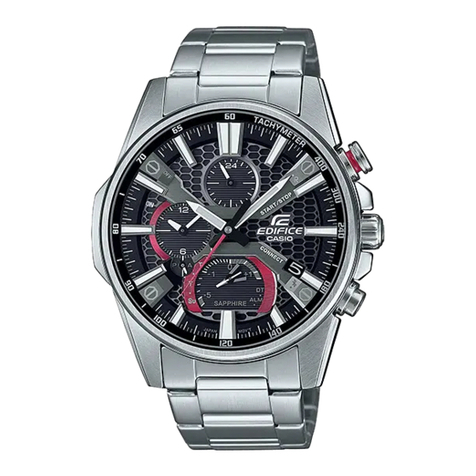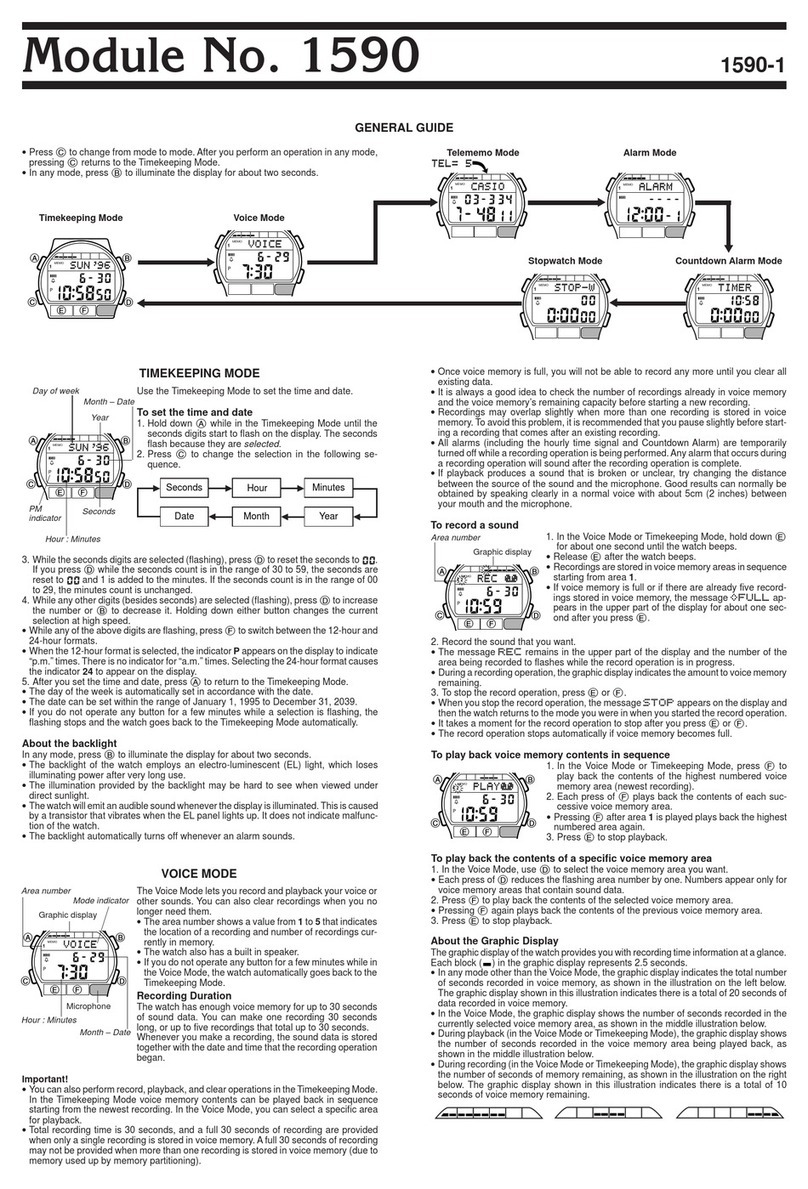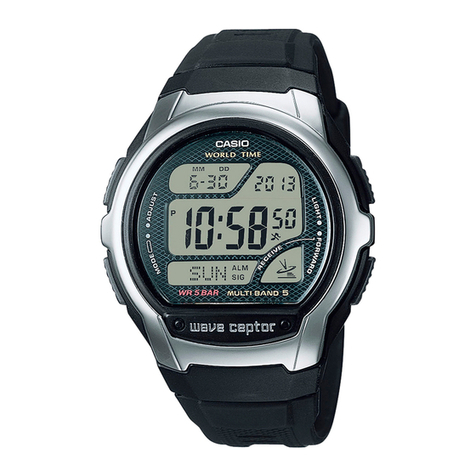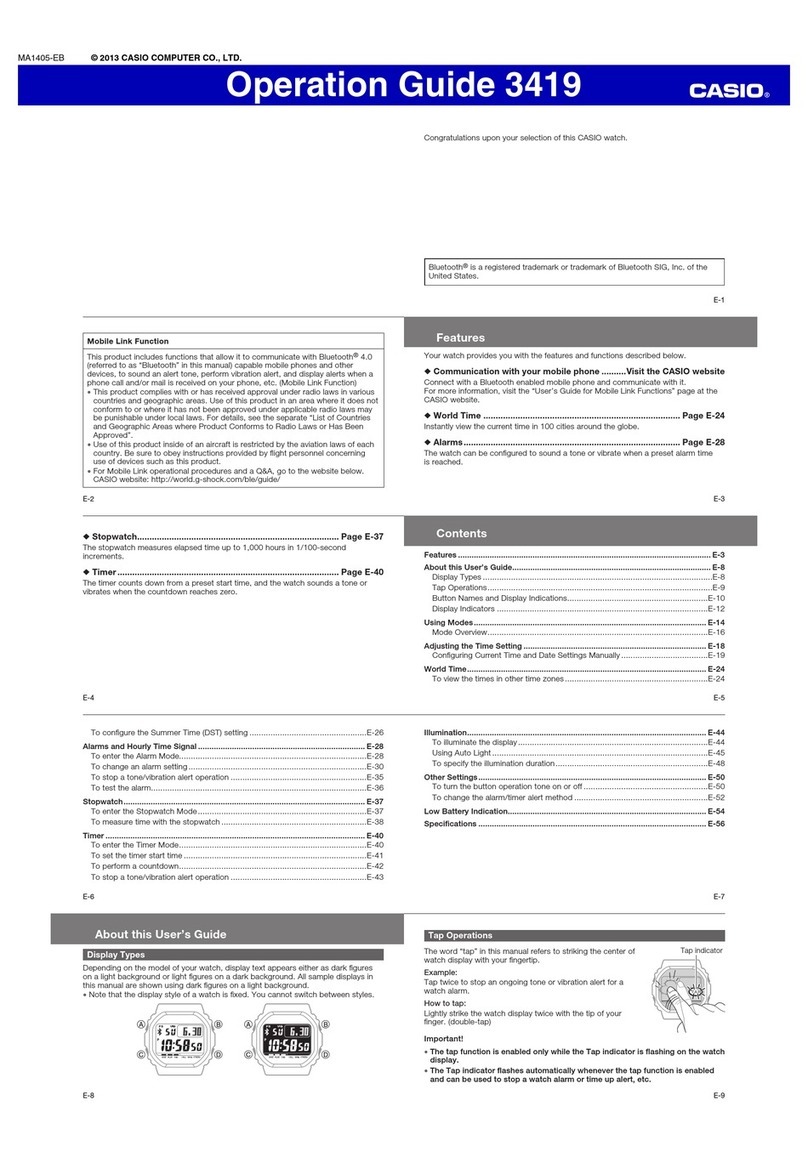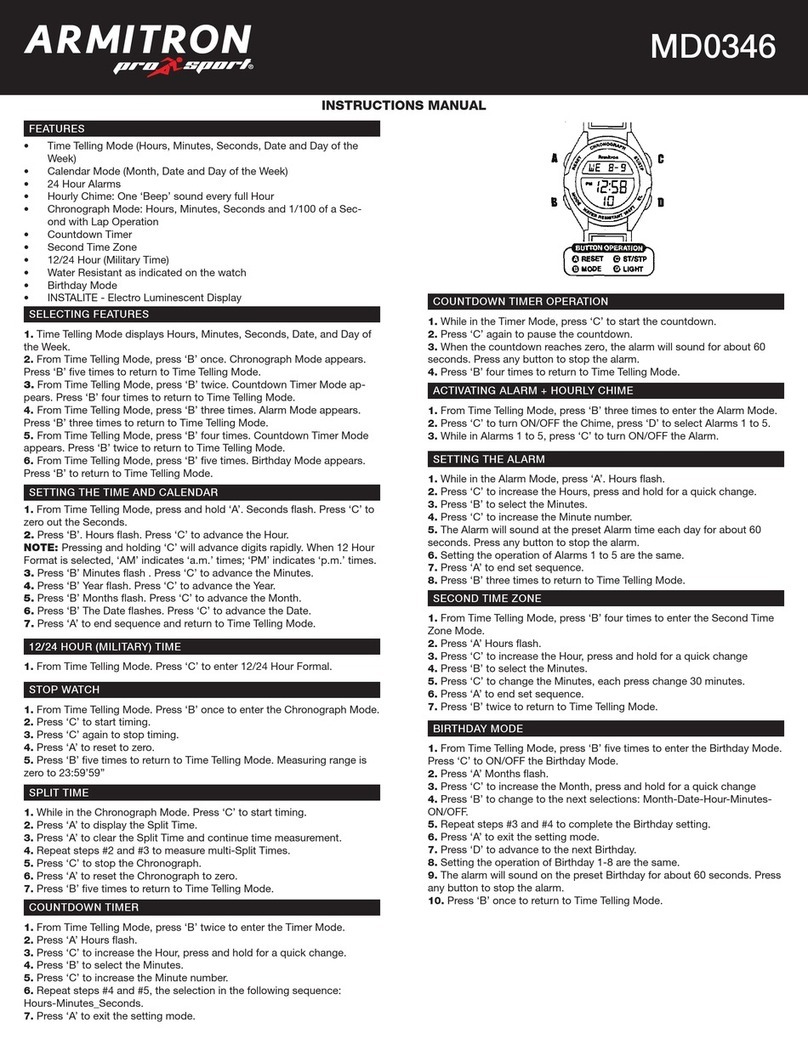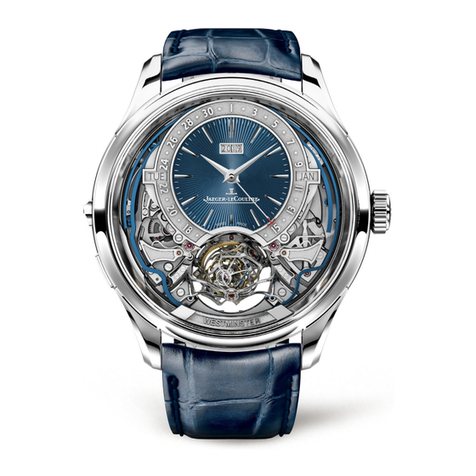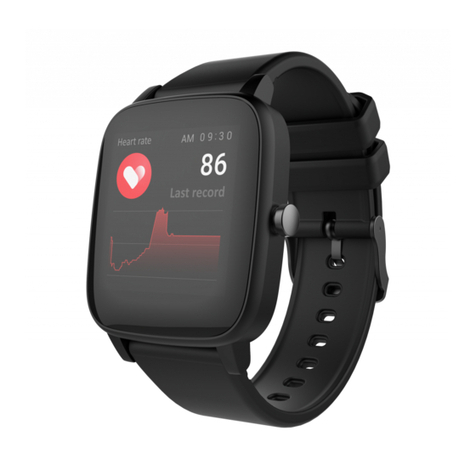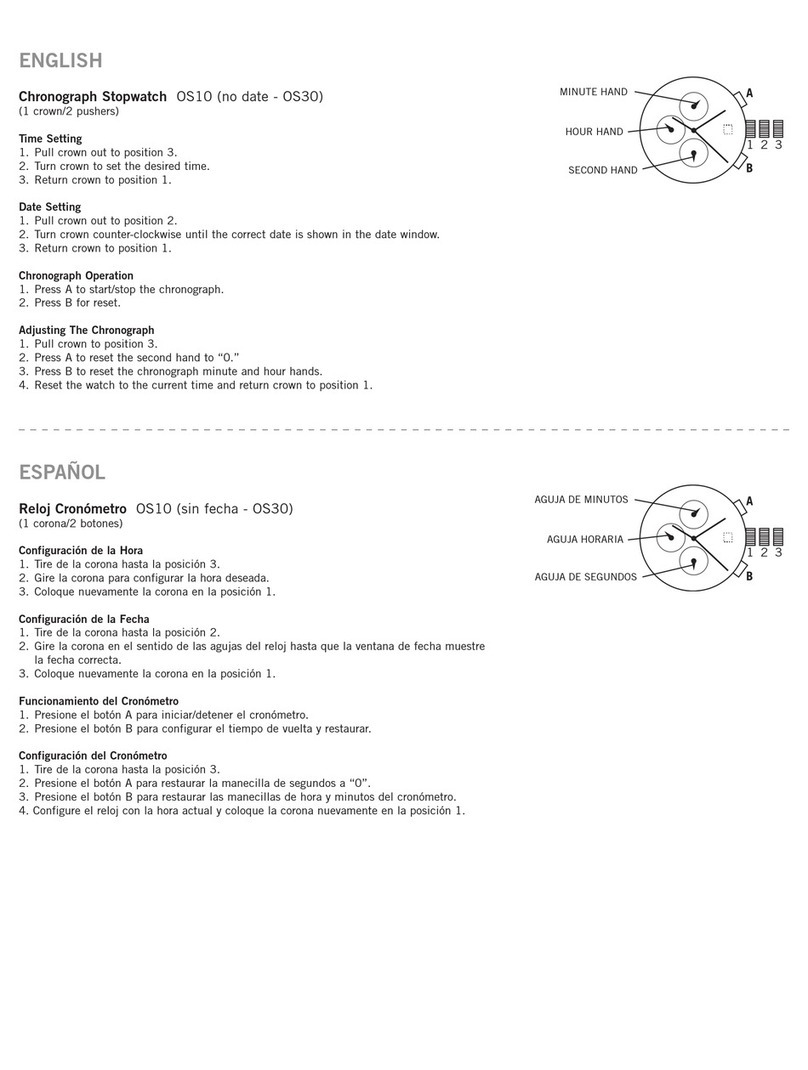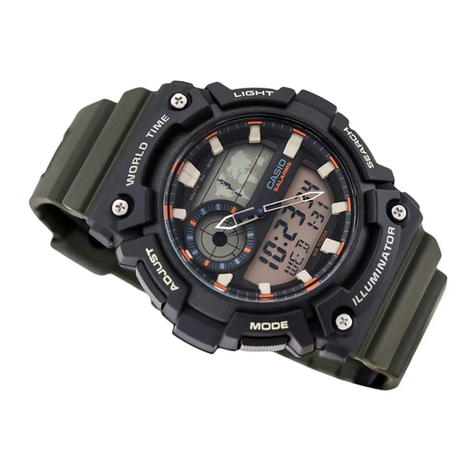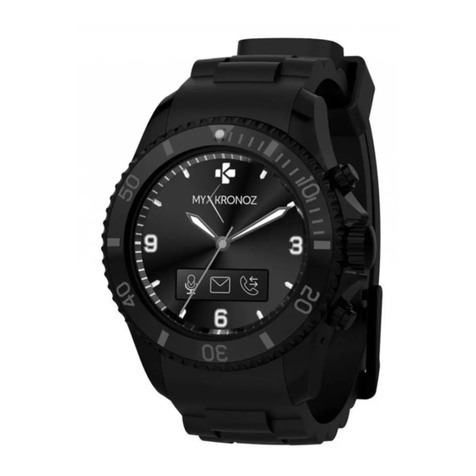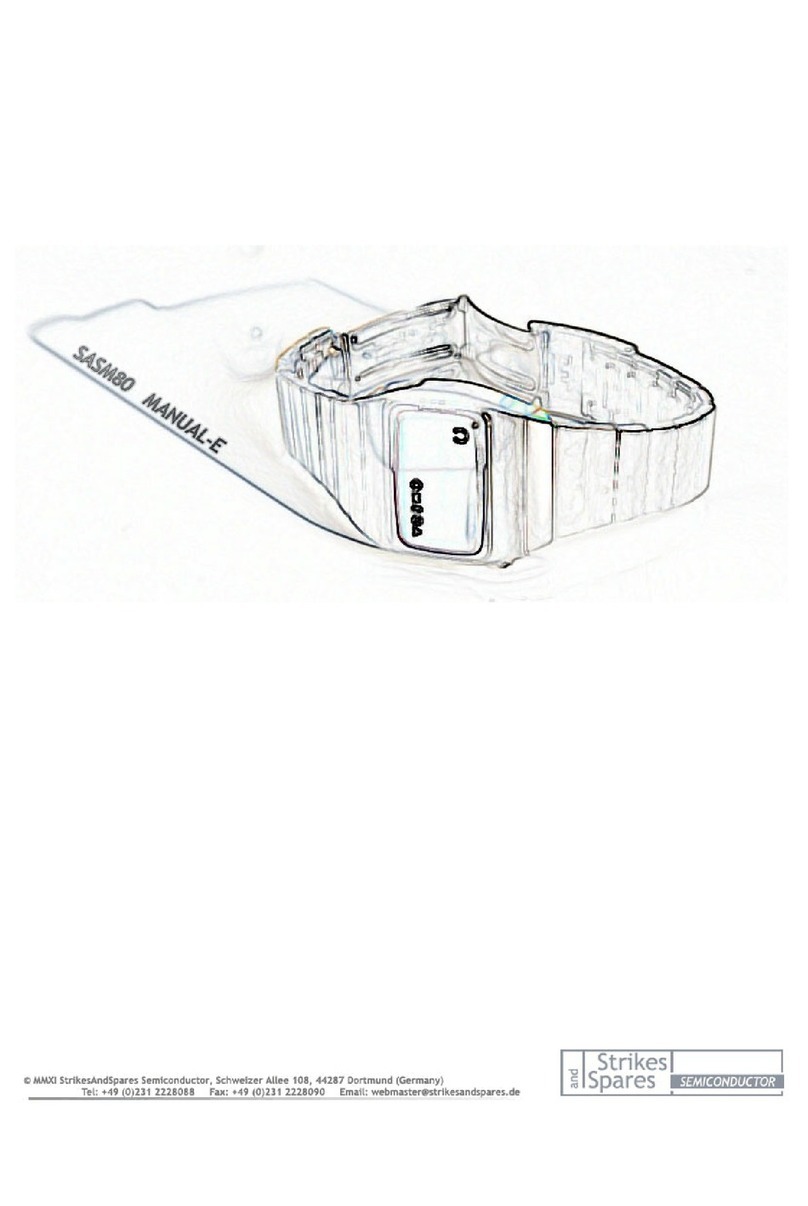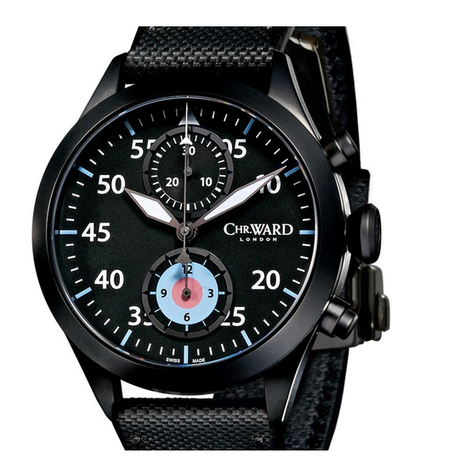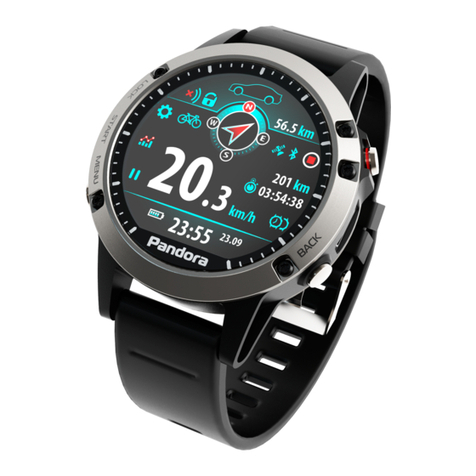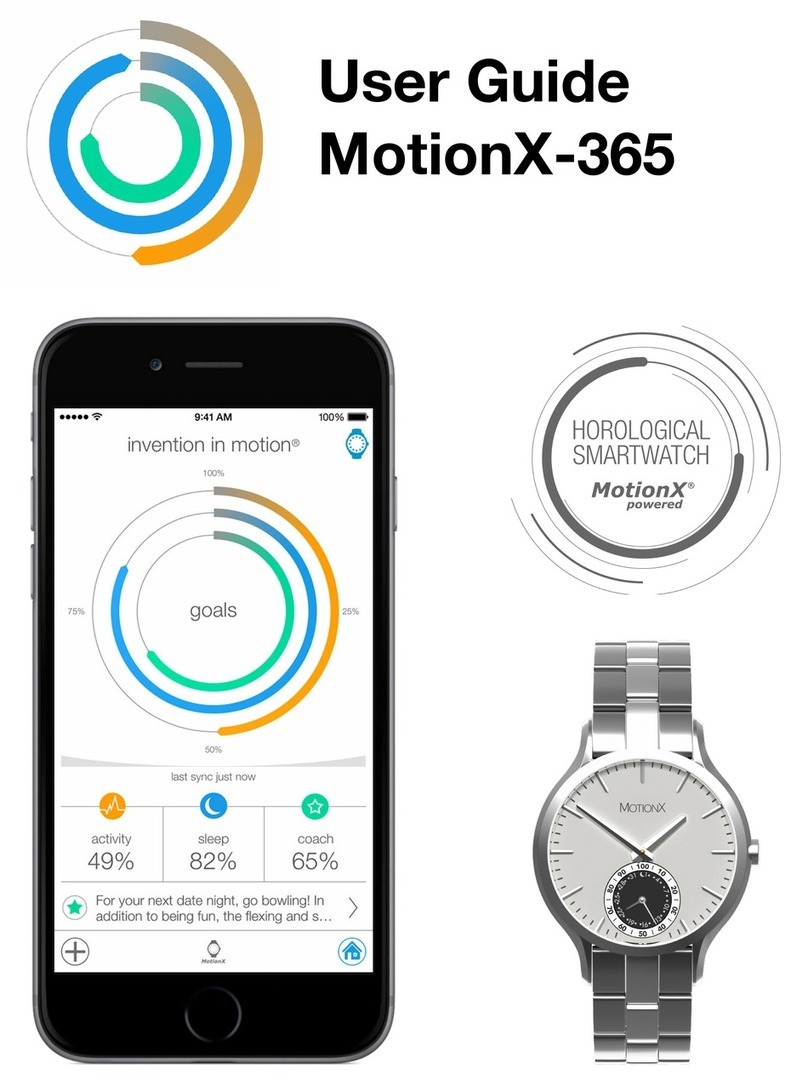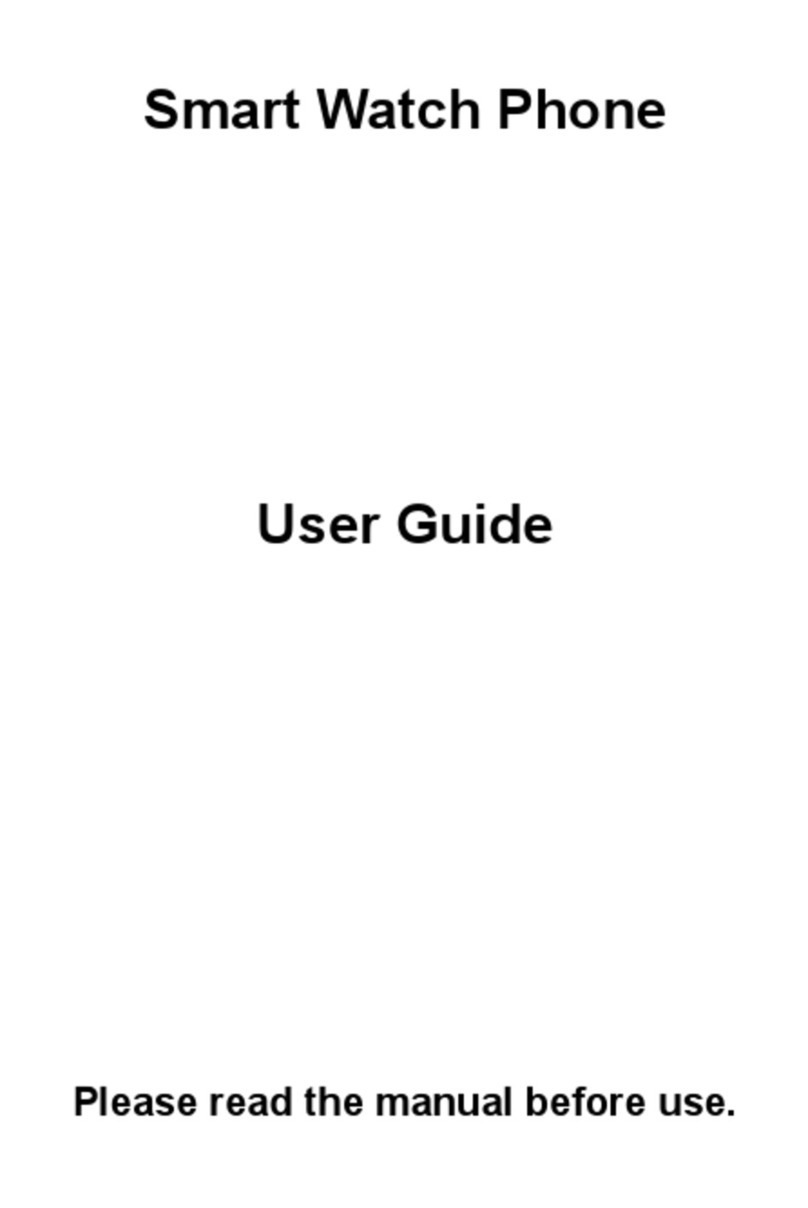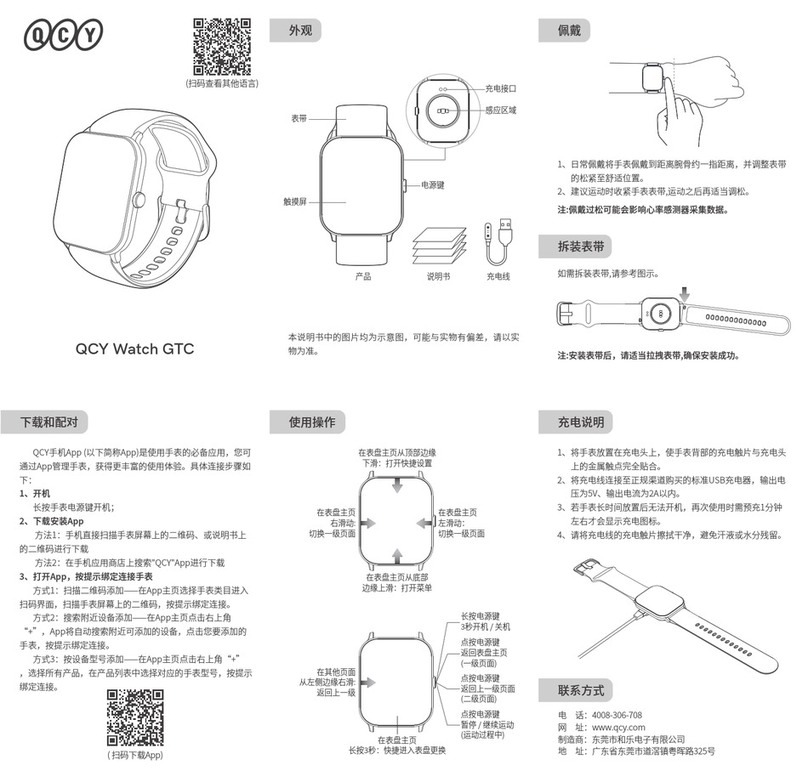
Operation Guide 2406 2583 2587
3
Reference
This section contains more detailed and technical information about watch operation.
It also contains important precautions and notes about the various features and
functions of this watch.
Auto Return Features
•If you leave the watch in Alarm, Date Alert, or Time Zone Mode for about 10 seconds
without performing any operation, it automatically returns to the Timekeeping Mode.
•If you leave a screen with flashing digits on the display for two or three minutes
without performing any operation, the watch automatically saves any settings you
have made up to that point and exits the setting screen.
Scrolling
The Aand Cbuttons are used in various modes and setting screens to scroll
through data on the display. In most cases, holding down these buttons during a scroll
operation scrolls through the data at high speed.
Timekeeping
•Pressing Aor Cwhile setting the time in the Timekeeping Mode resets the
second’s count to zero.
•The second’s count is restarted when you press Dto advance to the date setting
screen or Bto exit the setting screen.
•The day of the week is automatically displayed in accordance with the date (year,
month, and day) settings.
•The year can be set in the range of 1997 to 2096.
•The watch’s built-in full automatic calendar automatically makes allowances for
different month lengths and leap years. Once you set the date, there should be no
reason to change it except after you have the watch’s battery replaced.
•Home Time is displayed in 12-hour format, while UTC is always displayed in 24-hour
format.
•The PM (Module 2406: PM; Modules 2583, 2587: P) indicator appears to the left of
the hour digits for times in the range of noon to 11:59 p.m. and no indicator appears
to the left of the hour digits for times in the range of midnight to 11:59 a.m.
UTC
The letters “UTC”stands for “Universal Time Coordinated,”which is the world-wide
scientific standard of timekeeping. It is based upon carefully maintained atomic
(cesium) clocks that keep accurate to within microseconds. Leap seconds are added
or subtracted as necessary to keep UTC in sync with the Earth’s rotation. The
reference point for UTC is Greenwich, England.
Time Calibration Signal Reception Precautions
•This watch receives the time calibration signal (Call
Sign: WWVB) transmitted from Fort Collins, Colorado.
Signal reception is possible within a radius of about
2,000 miles (3,000 kilometers) from the Fort Collins
transmitter.
•At distances further than about 600 miles (1,000
kilometers) from the transmitter, signal reception may
not be possible during certain times of year or times of
day. Radio interference may also cause problems with
reception.
•The current time setting in accordance with the time calibration signal takes priority
over any time settings you make.
•The watch is designed to automatically update the date and day of the week for the
period January 1, 1997 to December 31, 2096. Setting of the date by the time
calibration signal cannot be performed starting from January 1, 2097.
•This watch can receive signals that differentiate between leap years and non-leap
years.
•Reception stops if an alarm starts to sound while the signal is being received.
•Even when the watch is within the reception range, signal reception is impossible if
the signal is blocked by mountains or other geological formations between the watch
and signal source.
•Signal reception is affected by weather, atmospheric conditions, and seasonal
changes.
•The time calibration signal is bounced off the ionosphere. Because of this, such
factors as changes in the reflectivity of the ionosphere, as well as movement of the
ionosphere to higher altitudes due to seasonal atmospheric changes or the time of
day may change the reception range of the signal and make reception temporarily
impossible.
•Even if the time calibration signal is received properly, certain conditions can cause
the time setting to be off by up to one second.
•Think of the watch as acting like a TV or radio when it is receiving the calibration
signal. When receiving indoors, move to a location as near as possible to a window.
Proper signal reception can be difficult or even impossible under the conditions
listed below.
Near TVs, refrigerators, computers, or other household appliances
Far away from broadcasting stations among ferro-concrete structures or near
mountains
Underground, in tunnels or in ferro-concrete buildings
Near high-tension wires, neon signs, or radio stations with interfering frequencies
Near railroads, highways or airports
In trains or cars
•Radio interference can make signal reception impossible.
•Strong electrostatic charge can result in the wrong time being set.
•If you are in an area where proper time calibration signal reception is impossible, the
watch keeps time within ±20 seconds a month at normal temperature.
Backlight Precautions
The backlight uses an EL (electro-luminescent) panel that causes the entire display to
glow for easy reading in the dark. In any mode, press Lto illuminate the display for
about three seconds.
•The electro-luminescent panel that provides illumination loses power after very long
use.
•The illumination provided by the backlight may be hard to see when viewed under
direct sunlight.
•The watch may emit an audible sound whenever the display is illuminated. This is
due to vibration of the EL panel used for illumination, and does not indicate
malfunction.
•The backlight automatically turns off whenever an alarm sounds.
•Frequent use of the backlight shortens the battery life.
Low Power Battery Precautions
•The indicator ( ) on the display indicates normal battery power. The indicator
changes to a flashing when battery power is low.
•Though backlight, alarm, and signal receive operations are possible when the
indicator ( ) is flashing on the display, you should avoid performing these operations
because they require high amounts of power. Have the battery replaced by the store
or dealer where you purchased the watch as soon as possible.
Fort Collins
2,000 miles
600 miles
Time Zone Table
–12h
–11h
–10h
–9h
–8h
–7h
–6h
–5h
–4h
–3h
–2h
–1h
0h
1h
2h
3h
4h
5h
6h
7h
8h
9h
10h
11h
12h
PAGO PAGO
HONOLULU, PAPEETE
ANCHORAGE, NOME
LOS ANGELES, SAN FRANCISCO, LAS VEGAS, VANCOUVER,
SEATTLE, DAWSON CITY, TIJUANA
DENVER, EL PASO, EDMONTON, CULIACAN
CHICAGO, HOUSTON, DALLAS/FORT WORTH, NEW ORLEANS,
MEXICO CITY, WINNIPEG
NEW YORK, MONTREAL, DETROIT, MIAMI, BOSTON, PANAMA CITY,
HAVANA, LIMA, BOGOTA
CARACAS, LA PAZ, SANTIAGO, PORT OF SPAIN
RIO DE JANEIRO, SAO PAULO, BUENOS AIRES, BRASILIA,
MONTEVIDEO
PRAIA
LONDON, DUBLIN, LISBON, CASABLANCA, DAKAR, ABIDJAN
BERLIN, PARIS, MILAN, ROME, MADRID, AMSTERDAM, ALGIERS,
HAMBURG, FRANKFURT, VIENNA, STOCKHOLM
CAIRO, JERUSALEM, ATHENS, HELSINKI, ISTANBUL, BEIRUT,
DAMASCUS, CAPE TOWN
JEDDAH, KUWAIT, RIYADH, ADEN, ADDIS ABABA, NAIROBI,
MOSCOW
DUBAI, ABU DHABI, MUSCAT
KARACHI, MALE
DHAKA, COLOMBO
BANGKOK, JAKARTA, PHNOM PENH, HANOI, VIENTIANE
HONG KONG, SINGAPORE, KUALA LUMPUR, BEIJING, TAIPEI,
MANILA, PERTH, ULAANBAATAR
TOKYO, SEOUL, PYONGYANG
SYDNEY, MELBOURNE, GUAM, RABAUL
NOUMEA, PORT VILA
WELLINGTON, CHRISTCHURCH, NADI, NAURU ISLAND
Time Zone Major cities in same time zone
Differential
•Based on data as of December 2002.

